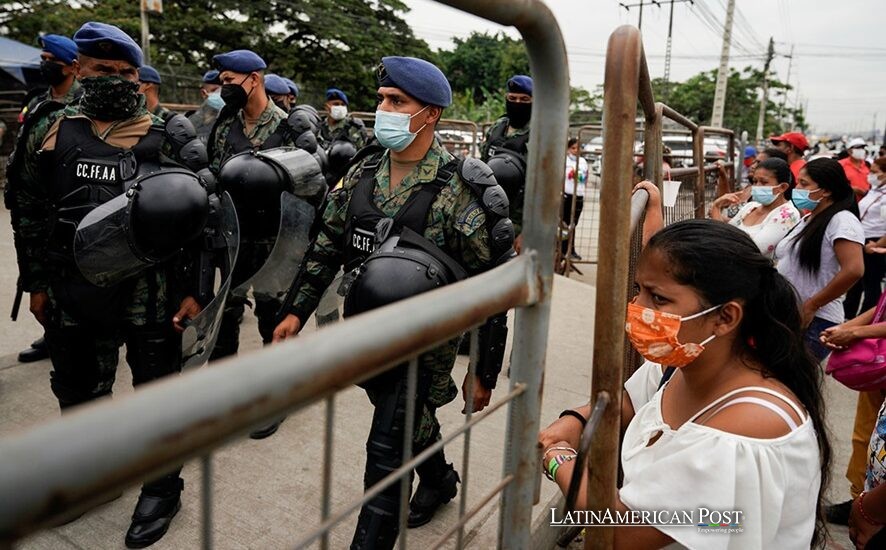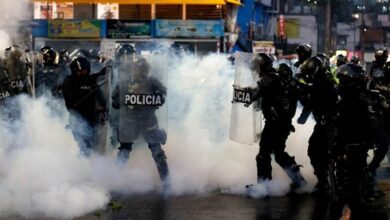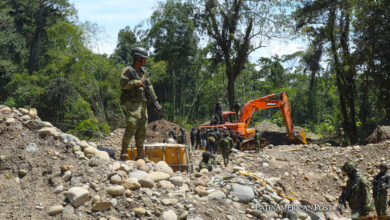Ecuador’s Largest Prison: Battling Gangs, Disease, and Despair

In Guayaquil’s infamous Penitenciaría del Litoral, Ecuador’s biggest and most lethal prison, violence and illness converge during a battle for dominance. Because gangs wage territorial conflicts within decaying walls, officials work hard to manage tuberculosis epidemics and reestablish a sense of stability.
A War Zone Within the Walls
The Penitenciaría del Litoral, in Guayaquil, is well known as Ecuador’s largest and most packed prison. The prison has space for around 3,900 inmates, but about 7,107 currently reside there. During the past four years, gang violence has led to over 300 deaths inside the walls. Increasingly, however, the carnage of gang battles is not the only threat. Penitenciaría del Litoral now faces the daunting challenge of stopping tuberculosis (TB) from turning into an epidemic.
Military personnel have been deployed to quell violence and prevent the horrifying large-scale riots that have claimed scores of lives. Authorities must now contend with a two-pronged crisis: preventing lethal clashes among rival gangs and containing the spread of a severe infectious disease.
Evidence of the prison’s violent past is everywhere. During a recent tour of Penitenciaría del Litoral, the Armed Forces worked to erase the traces of repeated uprisings that peaked in 2021 but have flared up sporadically for years. Rubble, scorched walls, and broken infrastructure serve as grim reminders of an ongoing war among a dozen organized crime groups jostling for power.
“We’re repairing all the cells and the pavilions, changing the bars where needed, and sealing the holes (caletas) that different groups used to hide weapons, ammunition, and explosives,” the special military task force commander told EFE. Standing among partially reconstructed walls and cell blocks, he described the scale of the effort required to reclaim these corridors. Inmates have blown out entire sections of the prison in attempts to attack rivals and assert control over strategic vantage points.
More than half of the prison’s 12 cellblocks have now undergone necessary renovations, including installing reinforced steel sheets over doors so inmates cannot tamper with new locks. A hallway that people knew historically as “callejón de la muerte,” or “death alley,” is also closed. Rival gangs once exploited this common corridor to raid other pavilions and begin deadly assaults.
Despite these measures, the challenge remains steep. Military officials aim to separate gangs by transferring them to freshly renovated blocks left vacant by rival groups, a strategy they believe has reduced the number of smuggled weapons. “They lived in the same blocks for so long that they could easily store guns and drugs in the walls,” said the commander in an interview with EFE. “Now, we find more hidden contraband every time we move them.”
Containing Tuberculosis
Stopping violence is vital, but tuberculosis poses a significant, hidden danger at Penitenciaría del Litoral. The recent deaths of four inmates, supposedly because of the infection, created concern within the prison and throughout Guayaquil. Local authorities worry the sickness may move from the packed cells to nearby areas.
Ecuador’s Ministry of Health currently counts inmates to determine the precise number of active TB cases. Officials state that 565 prisoners receive treatment. Some of them stay separated in Pavilion 7, which is also overcrowded. To lower contagion risks, the Ministry of Health provides inmates with influenza and other sickness vaccinations. The goal is to lessen problems that could worsen the spread of TB.
“The disease is under control,” claimed prison director Amado Muñoz to EFE, noting that more than 500 inmates have recently received vaccinations. Yet families of infected prisoners question the director’s optimism. They say their loved ones lack sufficient medical care, describing inadequate access to medications, substandard hygiene, and limited monitoring of their condition.
A Health Crisis Brewing
The possibility of a significant outbreak concerns everyone from prison officials to health workers and human rights organizations. Overcrowding, malnutrition, poor ventilation, and limited medical resources create ideal conditions for TB to take hold and spread. The prison population has almost doubled its design limit, so worries grow that disease spreads uncontrolled unless systematic checks happen.
Already dealing with gang issues besides hidden items, military officers say extra screening helps. One officer told EFE, “We need an X-ray scanner at the main gate,” stressing that smuggled goods include drugs, cell phones, and weapons. The comment addressed security, but a similar process functions well for health checks. When facilities detect sick inmates and separate these people rapidly, TB transmission lessens.
Desperate Families, Demands for Care
Each day outside the main gate, the inmates’ relatives congregate in an anxious watch. They display signs begging for improved living conditions and asserting that their family members do not get proper care. Because these groups frequently lack data about infected individuals and about the supply of medicine or fundamental hygiene, they worry.
One of them is Karina Meneses, whose son has been battling tuberculosis. She joined a small protest this week, begging to see him. “The last time I saw him, he was frail and deteriorating,” Meneses told EFE. “I don’t want to be told one day to pick him up at the morgue.” The plight of people like Meneses has caught the attention of local activists and international human rights organizations. They focus on ensuring that prisoners’ basic medical needs are met—a principle embodied in multiple conventions to which Ecuador is a signatory.
The Inter-American Commission on Human Rights (IACHR) has received complaints from NGOs and families claiming the Ecuadorian government is violating fundamental human rights by failing to provide adequate care. Already, these concerns have spotlighted the urgent question of whether Penitenciaría del Litoral can avert a widespread health crisis within its walls.
Government officials insist they are doing everything possible, citing joint operations between the Ministry of Health and the Armed Forces to rebuild facilities and conduct medical evaluations. Still, tangible improvements remain slow. Prisons across Ecuador have long been plagued by underfunding, poor administration, and minimal oversight—issues that do not simply disappear because of increased military presence.
As situations worsen, possible consequences extend past prison boundaries. Health professionals caution that contagious illnesses cross boundaries often – packed prisons act as ideal incubators. If not controlled, they might enter areas that already fight poverty, underfunded medical services, and increased crime numbers.
Penitenciaría del Litoral, having decaying structures plus a growing prisoner count, represents the core of Ecuador’s complex prison problem. People try to close concealed stockpiles, shift prisoners between buildings, and care for those who suffer from tuberculosis but face substantial obstacles concerning materials, organization, and administrative resolve. Because they are scared of violence plus disease, prisoners’ kin constantly demand increased openness and improved treatment for their families.
Also Read: El ELN de Colombia rechaza la paz: Tensiones, guerra e incertidumbre
Regarding oversight from the military, local health officials, and civil rights organizations, the prison’s destiny connects to more significant matters about government, the social disparity in Ecuador, and overall health. Accounts of concealed guns destroyed walls and disregarded sickness illustrate an intensified battle for dominance and compassion. Sustained focus and modification are essential if lasting optimism exists for Penitenciaría del Litoral and the whole nation.





